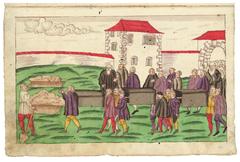Plague doctor and strawman
A brief overview of Thomas Schöpf’s life:
- 1520: born in Breisach am Rhein
- 1541-43: studies of the free arts in Basel
- 1544-46: studies in Wittenberg, Master of Arts (Magister Artium)
- 1547: position as teacher at the Stadtschule St. Peter in Basel and marriage to Anna Suracher
Anna was the oldest daughter of the innkeeper Stefan Suracher. Anna and Thomas had three children. - 1552-53: studies of medicine in Montpellier, graduation in Valence with a doctorate of medicine
- 1554-64: town physician of Colmar, the family stayed in Basel. Anna dies by plague, of the three children only daughter Anna (1548) survives. 1564: marriage to Elsbeth Hoffmann
- 1564: The city of Bern appoints Schöpf as town physician. Relocation from Colmar to Bern into the Doktorhaus (the physician’s residence) with daughter Anna and wife Elsbeth, with whom Schöpf had four sons.
- 1577: Contraction of the plague, death on the 16th of July
Schöpf’s call to in Bern was rooted in shared interests: the destitute publisher Adelberg Sauracker (before 1528-1592) from Basel and Bernese Ratsherr Niklaus Zurkinden (1506-1588), publicist, then town clerk and later general commissioner of the Canton of Waadt, shared the vision of a large map of the city republic of Bern. As the council administration would have opposed the publication of such a map, Sauracker’s brother-in-law Schöpf became the strawman for the map and was appointed as plague doctor of Bern for this reason.
In 1564 the plague was raging in Bern and Schöpf’s main focus was his work in the clinic and home-visits, which left him with little time to spare. Meanwhile, the map was developed by his entourage: Zurkinden’s son-in-law Martin Krumm, a Bernburger, illustrator, painter, and Visierer, manufactured sketches of Bernese landscapes. Zurkinden himself authored the chorography. The copying was assigned to scribe Jakob Bucher, who, as the husband of Schöpf’s daughter Anna, was privy to the secret of the authorship. The work took place in the workshop of Schöpf’s Doktorhaus.
The map was printed in 1578, a year after Schöpf’s death. For reasons of concealment, Schöpf’s entourage brought the production of maps to a halt. The 18 printing plates at Jobin in Strasbourg were requisitioned. In 1672 they were reused for a reprint for the council.

